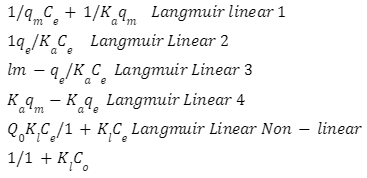Adsorption isotherms have proven to be extremely useful in research pertaining to environmental protection and adsorption techniques, among other things. The Freundlich and Langmuir isotherms are the two primary methods for predicting the adsorption capacity of a given material, and they are both used in the same way.
Freundlich Adsorption Thermodynamics
According to Freundlich adsorption, for a given temperature and unit mass of solid adsorbent, the amount of gas adsorbed by a unit mass of solid adsorbent changes in proportion to the change in pressure of the system.
When n > 1, the Freundlich isotherm expression can be represented as follows:
P is the pressure, and n is a constant that depends on the nature of the adsorbent and the gas at a given temperature. Where x denotes the mass of gas adsorbed, and m denotes the mass of adsorbent. Taking the logarithm on both sides of the equation, we get the following result:
Isotherms of Adsorption in the Langmuir Zone
The Freundlich adsorption isotherm is followed by two other isotherms, the Langmuir adsorption isotherms and the BET theory, which are all related to adsorption. At low adsorption densities, linear adsorption is predicted, while maximum surface coverage is predicted at high solute metal concentrations according to the Langmuir adsorption isotherms.

The Langmuir adsorption isotherm has the following shape: =Kp1+Kp
Where
The fraction of the surface covered by the adsorbed molecule is denoted by the symbol.
K is an equilibrium constant that is also referred to as the adsorption coefficient.
{ K= ka/kd = rate constant for adsorption/ rate constant for desorption}
The pressure is represented by the letter p.
It is possible to use the Langmuir adsorption technique for monolayer adsorption onto a homogeneous surface when there is no interaction between the adsorbed species.
The Adsorption Isotherm of BET
The Brunauer, Emmett, and Teller (BET) theory of multilayer adsorption, first proposed in 1938, is based on the assumption that physisorption results in the formation of multilayer adsorption. The theory also assumes that the adsorption sites on the solid surface are uniform in size and that adsorption at one site has no effect on adsorption at nearby sites.
Following the formation of the monolayer, the adsorption process can proceed to the formation of a multilayer, which may include the formation of a second layer, a third layer, and so forth.
![]()
Applications of Adsorption (Adsorption) is the equation for BET.
The following are some examples of adsorption’s uses:
When coal miners wear gas masks, poisonous gases become adsorbent on the surface of the mask, preventing them from coming into contact with them.
Vacuum is created by adsorbing traces of air on charcoal and removing them from devices that are undergoing the evacuation process.
Removal of moisture: Silica gel pellets are used in the adsorption of moisture in medicines and new plastic bottles in order to regulate humidity levels in the environment.
To get a clear liquid solution, the juice extracted from cane is treated with animal charcoal to remove the colouring agent, which results in a clear liquid solution.
Suitable materials are used as catalysts in such a way that reactants adhere to the surface of the catalyst, allowing the reaction to proceed more quickly and thus increasing the rate of reaction.
Conclusion
Therefore we can finally conclude that a graph is commonly used to illustrate and study the adsorption process. This is called adsorption isotherm. Different scientists have developed different kinds of adsorption isotherms. Adsorption isotherms have proven to be extremely useful in research pertaining to environmental protection and adsorption techniques, among other things.
 Profile
Profile Settings
Settings Refer your friends
Refer your friends Sign out
Sign out






